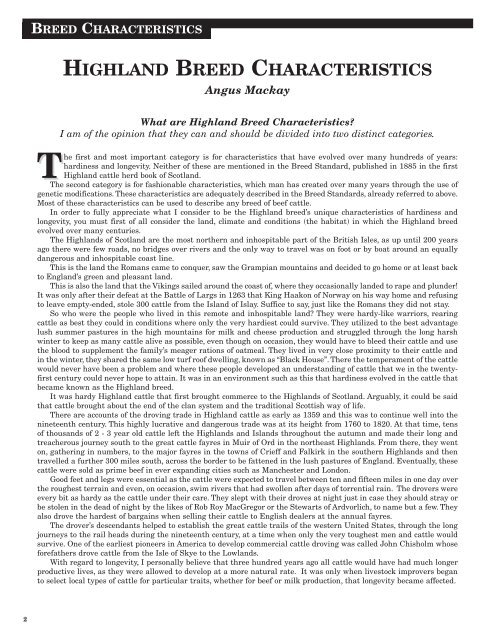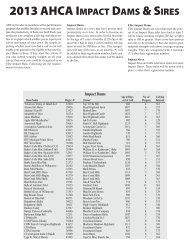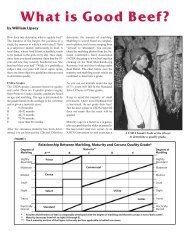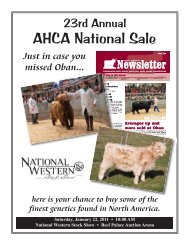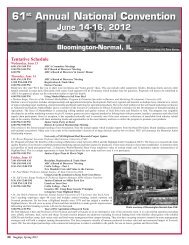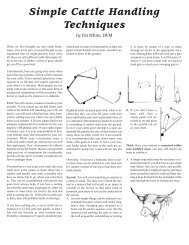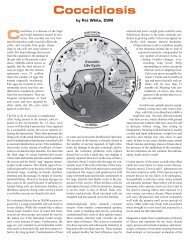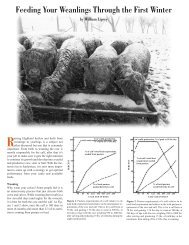The Bagpipe - American Highland Cattle Association
The Bagpipe - American Highland Cattle Association
The Bagpipe - American Highland Cattle Association
You also want an ePaper? Increase the reach of your titles
YUMPU automatically turns print PDFs into web optimized ePapers that Google loves.
2<br />
BREED CHARACTERISTICS<br />
HIGHLAND BREED CHARACTERISTICS<br />
Angus Mackay<br />
What are <strong>Highland</strong> Breed Characteristics?<br />
I am of the opinion that they can and should be divided into two distinct categories.<br />
<strong>The</strong> first and most important category is for characteristics that have evolved over many hundreds of years:<br />
hardiness and longevity. Neither of these are mentioned in the Breed Standard, published in 1885 in the first<br />
<strong>Highland</strong> cattle herd book of Scotland.<br />
<strong>The</strong> second category is for fashionable characteristics, which man has created over many years through the use of<br />
genetic modifications. <strong>The</strong>se characteristics are adequately described in the Breed Standards, already referred to above.<br />
Most of these characteristics can be used to describe any breed of beef cattle.<br />
In order to fully appreciate what I consider to be the <strong>Highland</strong> breed’s unique characteristics of hardiness and<br />
longevity, you must first of all consider the land, climate and conditions (the habitat) in which the <strong>Highland</strong> breed<br />
evolved over many centuries.<br />
<strong>The</strong> <strong>Highland</strong>s of Scotland are the most northern and inhospitable part of the British Isles, as up until 200 years<br />
ago there were few roads, no bridges over rivers and the only way to travel was on foot or by boat around an equally<br />
dangerous and inhospitable coast line.<br />
This is the land the Romans came to conquer, saw the Grampian mountains and decided to go home or at least back<br />
to England’s green and pleasant land.<br />
This is also the land that the Vikings sailed around the coast of, where they occasionally landed to rape and plunder!<br />
It was only after their defeat at the Battle of Largs in 1263 that King Haakon of Norway on his way home and refusing<br />
to leave empty-ended, stole 300 cattle from the Island of Islay. Suffice to say, just like the Romans they did not stay.<br />
So who were the people who lived in this remote and inhospitable land? <strong>The</strong>y were hardy-like warriors, rearing<br />
cattle as best they could in conditions where only the very hardiest could survive. <strong>The</strong>y utilized to the best advantage<br />
lush summer pastures in the high mountains for milk and cheese production and struggled through the long harsh<br />
winter to keep as many cattle alive as possible, even though on occasion, they would have to bleed their cattle and use<br />
the blood to supplement the family’s meager rations of oatmeal. <strong>The</strong>y lived in very close proximity to their cattle and<br />
in the winter, they shared the same low turf roof dwelling, known as “Black House”. <strong>The</strong>re the temperament of the cattle<br />
would never have been a problem and where these people developed an understanding of cattle that we in the twentyfirst<br />
century could never hope to attain. It was in an environment such as this that hardiness evolved in the cattle that<br />
became known as the <strong>Highland</strong> breed.<br />
It was hardy <strong>Highland</strong> cattle that first brought commerce to the <strong>Highland</strong>s of Scotland. Arguably, it could be said<br />
that cattle brought about the end of the clan system and the traditional Scottish way of life.<br />
<strong>The</strong>re are accounts of the droving trade in <strong>Highland</strong> cattle as early as 1359 and this was to continue well into the<br />
nineteenth century. This highly lucrative and dangerous trade was at its height from 1760 to 1820. At that time, tens<br />
of thousands of 2 - 3 year old cattle left the <strong>Highland</strong>s and Islands throughout the autumn and made their long and<br />
treacherous journey south to the great cattle fayres in Muir of Ord in the northeast <strong>Highland</strong>s. From there, they went<br />
on, gathering in numbers, to the major fayres in the towns of Crieff and Falkirk in the southern <strong>Highland</strong>s and then<br />
travelled a further 300 miles south, across the border to be fattened in the lush pastures of England. Eventually, these<br />
cattle were sold as prime beef in ever expanding cities such as Manchester and London.<br />
Good feet and legs were essential as the cattle were expected to travel between ten and fifteen miles in one day over<br />
the roughest terrain and even, on occasion, swim rivers that had swollen after days of torrential rain. <strong>The</strong> drovers were<br />
every bit as hardy as the cattle under their care. <strong>The</strong>y slept with their droves at night just in case they should stray or<br />
be stolen in the dead of night by the likes of Rob Roy MacGregor or the Stewarts of Ardvorlich, to name but a few. <strong>The</strong>y<br />
also drove the hardest of bargains when selling their cattle to English dealers at the annual fayres.<br />
<strong>The</strong> drover’s descendants helped to establish the great cattle trails of the western United States, through the long<br />
journeys to the rail heads during the nineteenth century, at a time when only the very toughest men and cattle would<br />
survive. One of the earliest pioneers in America to develop commercial cattle droving was called John Chisholm whose<br />
forefathers drove cattle from the Isle of Skye to the Lowlands.<br />
With regard to longevity, I personally believe that three hundred years ago all cattle would have had much longer<br />
productive lives, as they were allowed to develop at a more natural rate. It was only when livestock improvers began<br />
to select local types of cattle for particular traits, whether for beef or milk production, that longevity became affected.


